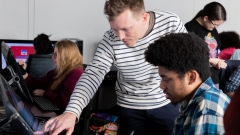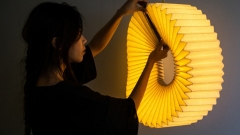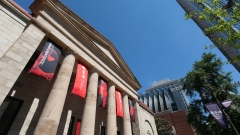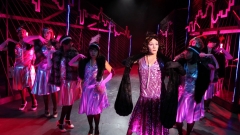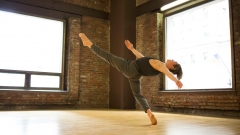Inauguration 2016
<< back to President's Speeches
President David Yager
Inauguration Speech — “Imagine”
October 17, 2016
Merriam Theater
Part One
Thank you Chairman Lutsky, and thank you to Mayor Kenney for joining us on this special day.
“A place where the rules no longer apply.” That’s one definition of “liminality.” It can signify transition; the space between; being at the threshold of something.
WE find ourselves at the threshold here today. Maybe that’s the place art always finds itself—the unknown; the blank canvas; a place of uncertainty and transformation. WE can’t predict the future, but we can imagine it—WE are artists.
“You were great. You were beyond great. You were incredible.”
These are some of the final lines of Ron Yerxa’s wonderful film Little Miss Sunshine.
I want to shine some light on a future that I believe will be “incredible.” So, how will others see us 10 years from now? How will we see ourselves?
I ask you to close your eyes.
-
Imagine what our University will look like in the year 2026
-
Imagine a ribbon-cutting ceremony for our new building, The Institute of Collaborative Arts and Design.
-
Imagine students moving into a brand new residence hall that has a performing arts space, a gallery, a health and wellness facility, dining halls and gathering places for all of our undergraduate students…a space where living and creating exist seamlessly.
-
Imagine the Corzo Center for the Creative Economy occupies an entire floor of Terra Hall—and engages with UArts students and the city of Philadelphia.
-
Imagine our new library on which visitors want to model their new space based on our innovative concept of a library of the future, with students and faculty in a learning living and exploring environment.
-
Imagine when a degree in the arts is valued by society as much as a degree in business, science, or engineering, and that the University of the Arts is the recognized best place to obtain that degree.
-
Imagine parents are calling UArts Trustees asking “Can you help get our son or daughter admitted to the University of the Arts,” and our waiting lists continue to grow.
-
Imagine the City of Philadelphia and the School District of Philadelphia working with UArts to ensure that every child in the city gets access to high-quality arts educational experiences.
-
Imagine people are calling me and our Trustees on a regular basis asking how to become a University of the Arts Trustee.
-
Imagine an Institute that breaks through traditional notions of “the teaching museum”— a performance incubator space, a maker space, a home for collaboration and innovation.
-
Imagine every student at UArts has the opportunity to do an internship related to their potential future careers.
Part Two
I’m going to ask you to close your eyes again.
-
Imagine we have the powers of a Stan Lee superhero to continue envisioning the future
-
So close your eyes, again, as we imagine the future
-
Imagine the University of the Arts reaches learners of all ages across the globe through relevant, high quality, unique online coursework that is easy to access.
-
Imagine exceptionally talented and motivated high school students travel to Philadelphia from around the globe to study in UArts’ Pre-college Summer Institute, not only because it is an excellent college preparatory program but also because they want to increase their chances of being accepted into UArts.
-
Imagine the University of the Arts has more endowed professorships than any art schools in the country. Last night we announced the first endowed chair in 140 year history at the University of the Arts; the Effron family endowed a chair in glass. Over the next five years, imagine we announce 10 new endowed chairs.
-
Imagine faculty in our new Research Centers will offer the first courses in our new interdisciplinary and transdisciplinary PhD programs. We’ve had our first committee meeting to discuss this, already.
-
Imagine UArts has built the finest state of the art contemporary exhibition space and has partnered with other exhibition venues.
-
Imagine graduate students in our new post-MFA Fellowship programs are leading dance programs in South America, Europe, Asia, and the Middle East. We currently enjoy the accolades of having a top-5-ranked dance program.
-
Imagine undergraduate students in our new Cross-Border collaborative studio are redefining what it means to be a citizen artist, and are meeting with institutions and artists around the world.
-
Imagine feeling a sense of pride when showing potential students and their parents our UArts facilities, the best in every discipline.
-
Imagine: a team of Writing for Film and TV graduates accepting an EMMY award.
-
Imagine start-ups in Philadelphia created by UArts alumni and students are popping up all over the country.
-
Imagine the University of the Arts is clearly the creative economic engine for Philadelphia business.
Part Three
- Imagine: UArts is featured in a major news story on American universities that have created new paradigms of teaching, learning, mentoring and in internships in the arts.
- Imagine we are the only university in the country with a student, an alum, and a faculty member in the 2020 Forbes Under 30 list.
- Imagine every Internet search of “best universities to study the Arts and Design in North America” includes UArts in top spots in every ranking list.
-
Imagine green and sustainable improvements to our buildings that would serve as “learning gardens” and settings to create/grow natural dyes for art-making, teaching courses on land art, or landscape design. Imagine a park or green space that students can call their own that allows for rotating sculptures/installations.
-
Imagine the leading business incubators and accelerators around the country are inviting us to help them build creative and innovative start-up companies.
-
Imagine UArts Arts and Design students and faculty are embedded in research and invested in the latest discoveries in the health care industry.
-
Imagine UArts students, upon graduation, have become Citizen Artists with individual missions to make a real, measurable difference in the world through their art.
-
Imagine our faculty are invited to Washington D.C. to lead a new initiative on social engagement in the arts.
-
Imagine multilingual faculty in Graphic Design evolve its signature approach to learning and communicating to the cultural contexts celebrated in the University’s branch campuses around the globe
-
Imagine we overhear this conversation on the streets of Philadelphia: “Do you know where the Kimmel Center is?” “Sure. It’s next to Hamilton Hall at the University of the Arts. Do you know where that is?” “Of course!”
-
Imagine a new residence hall with health and wellness facilities, a gallery and exhibition space, a performance space and a place for students to relax and meet other students.
-
Imagine a mural on Broad Street celebrating the University of the Arts 150th Anniversary.
-
Imagine we have the funds to provide scholarships for adults who wish to return to school or to change careers to enable them to pursue undergraduate and graduate degrees at UArts. We have the funds for scholarships to ensure any student admitted will be able to attend UArts. And we will raise funds so that no student has to drop out for lack of resources to complete his or her degree. How a number of students were not able to attend UArts this fall even though they had scholarships…and how $100,000 would save 5-7 students from not attending college.
-
AND…Imagine when the myth of the “starving artist” is completely obsolete— it doesn’t even make sense as a metaphor. Instead, people talk regularly about “the artist’s bounty,” recognizing how rich the life of an artist is, how rich art makes us all.
-
You can now open your eyes, since we don’t need to imagine our students’ power to captivate an audience.
Part Four
For 140 years— as we have seen today—our University has been resilient and agile. Our students and faculty are talented and tenacious, fearless and forward thinking. Our city is dynamic and creative. Our friends and supporters are enthusiastic and generous. Our alumni have demonstrated great ingenuity and leadership.
The University of the Arts will be what it has always been—distinctive and bold. And it will be like something we have never seen before. Because that is our obligation—and our passion—as artists and makers.
So, here we are at the threshold.
Celebrating 140 years of “the maker’s moment” and envisioning how we can build on the core values and the principles and the unique strengths that have brought us to this moment.
Many of you asked me why I came to UArts? The answer is, The Quality of the Faculty.
I spoke with a group of people and asked them if they remember the buildings that were built at their University or College, or do they remember the faculty who changed their lives?
Human creativity is the world’s most precious resource.
-
How do you focus on excellence, build top-tier programs and build reputations in disciplines with national visibility?
-
How do you be unique but focused on quality?
-
How do you be nimble and ready for change?
-
How do you build a “WE” culture?
As I have stated, Excellence rules over everything except culture. Build a strong culture so excellence and change are embraced and not feared. Excellence should drive decisions; the key is how to determine excellence and set goals and measure outcomes. Together today we have imagined a remarkable—and achievable—future.
The University of the Arts will be the most provocative, imaginative, entrepreneurial, socially engaged, authentic, and influential school of the arts in the country.
How will we get there?
It starts with Excellence.
-
Participation and provocation to evolve our role in the creative economy.
-
We need to understand and emphasize empathy
-
We need to focus on the capacity of the arts to help us cross borders of all kinds.
-
To create new partnerships and collaborations.
-
A drive to take risks. To challenge assumptions. To change the conversation about what it means to be an artist. To be a maker.
-
A commitment to the idea that hard work, persistence, and discipline are as important—if not more important and valuable—than sheer talent.
We will seek out new partnerships in our city and around the country to design new programs and develop new opportunities in our communities and in our organizations. Last night at the Gala we announced our partnership with the Kimmel Center; in the months ahead, we will hopefully be announcing other new and important partnerships. The first will be an exhibition by UArts faculty members in the Kimmel Center’s atrium.
We are standing at the threshold of something new. Mark today in your calendar, as we celebrating 140 years and this inauguration.
THIS IS A NEW GENERATION OF STUDENT. The average 18 year old spends 4,000 hours/year online—by the time students enter college, they have spent over 20,000 hours online and 10,000 hours playing games online. A recent study found they spend more time on their phone and the Internet than sleeping.
Everything kids do now is “customizable”—it’s on demand and mostly free: music is free; film and TV is free and scheduled; they customize clothing…
Then you have classes and performances that are scheduled—a particular time, a particular space.
We have opportunities.
Any 13-year-old can make a film now. How do we deal with a “professional” level capability without formal education? Artistic production has been “democratized,” as has distribution. Audience numbers are plummeting but artists’ numbers are exploding. Traditional artistic institutions and venues will continue to exist, but they are not the entire artist community.
With the rise of the “professional amateur-artist” — the “DIY” — working on social/political/environment issues in new ways and in new venues--we are already doing that and UArts is already leading the way.
The Arts have been “excised” like a tumor from public education; how do we embrace a student population with less awareness of the arts or what it means to be an artist? How do we as artists add value? How do we enhance the emotional intelligence of our community?
In an “on demand” world, the artist pushes boundaries, pushes you into the unexpected — and what is the value of those traits in this economy? In a marketplace defined by social consciousness, artists can take on the roles of:
-
Social Worker
-
Political-Mobilizer/Political Changer
-
Environmentalist
-
Philosophical “provocateur”
-
Boundary-pusher, “disruptive innovator”
-
“Integrator” of multiple disciplines :Art and Science; Design and Medicine; the Brain and the Arts
In a time of increasing ambiguity and uncertainty, there is nothing more important or valuable than an artist:
-
Having skills and imagination turns questions into creative solutions and problems into opportunities
-
Creative leadership…with empathy
-
Being comfortable with the unfamiliar
-
Artists are unafraid to cross borders, to take risks, to change the conversation and to be unpopular
-
The artist is the most prepared to deal with the uncertainty of the world around us
-
Don’t discount the concrete and compelling reality of building creative capital
I am a life-long student…always learning. To that end, I’ve learned over a number of years the value of building creative capital. In addition, with the dramatic changes in our social communications environment, there are many opportunities for artists to change our world. Consider the intersection of the qualitative (empathy, flexibility, curiosity) and the quantitative (community engagement, economic impact):
-
More than two million Americans are in creation or distribution of the arts, generating more than $700 billion annually
-
In Philly, 44,000 people work in arts-related businesses contributing $3.3 Billion each year
-
Employers in nearly every industry are seeking out creative people
-
The arts drive the resurgence and renewed vibrancy of America’s downtowns, and center city neighborhoods like here in Philadelphia
So, as I conclude…some questions for all of us to think about:
-
Do the arts and artists have a role to play in creating, building and sustaining “resilient cities” (or resilient communities), or for that matter, resilient people?
-
How will the arts and artists shape the way the world is evolving in terms of shaping demographics: we have more refugees than at any time in the last century; rapid urbanization; aging of the population; and emphasis on generational affiliations?
-
What role will the arts and artists play in advancing and evolving emerging technologies (A.I., augmented reality, 3D manufacturing and design, robotics, use of drones, wearable technologies)?
-
Which organizations will be looking to the arts and artists as an integral part of their teams for the first time (policy-makers, start-ups, global corporations, hospitals, community health agencies)?
-
What ethnical questions can the arts and artists address better than any other discipline (now and in the future)?
-
What role can the arts and artists play in future conversations about “sustainability”
-
What new models of financing the arts and artists can we expect to see or do we want to see?
-
The arts and artists embraced physics as a source of inspiration, new paradigms and collaborations in the ‘80s and ‘90s, in literature, theater, visual arts, music. They moved on to embrace biological sciences in the first 15 years of the 21st century. What is the next “scientific frontier” for artists/scientific exchange, and for exploration?
-
What types of “Arts Businesses” and entrepreneurial endeavors can we imagine over the next 5-10 years from now? What would we like to see that doesn’t exist now?
-
How will the definition of beauty evolve? How will the definition, for that matter, of “art” and the arts evolve?
-
Who will be the artists (and arts researchers or educators) best equipped and trained to deal with a world changing rapidly and in so many interconnected ways? What will it be like just a few years from now?
-
Can you imagine a time when it would occur naturally to the editors of a major publication to ask “20 Big Questions” about the future of humanity to artists, arts researchers and educators?
-
Can—or should—you imagine a “future of humanity” without the arts and artists?
-
How will the arts and artists continue to help us understand what it means to be human?
I want to thank all of you for joining us here today. I want to congratulate our Honorary Degree Recipients: Dr. Ron Yerxa, Dr. Stan Lee and Dr. Freeman Hrabowski.
I would like thank, again, the performers and visual artists who shared their talents with us, and their faculty, mentors and staff. I want to thank all of our students—this is all for you. I want to express my appreciation to the University of the Arts Board of Trustees. I want to thank my friends, family, faculty, staff, students and all the supporters of the University of the Arts.
Being a creative person isn’t necessarily easy…but you students can make a difference. Believe in the Arts and what you are doing.
As artists and educators, you can be leaders, trendsetters and your impact can be local and global. Your job is to help change the world.
If UArts were a stock, this is a time to invest. Our opportunities are endless.
I am proud and grateful to be named the fourth president of the University of the Arts.
Thank you!

